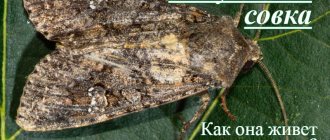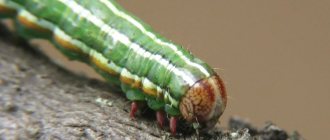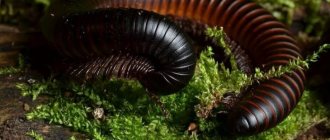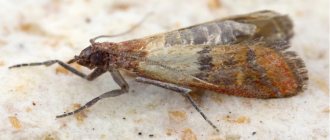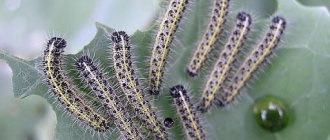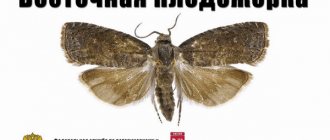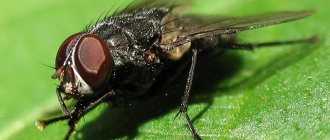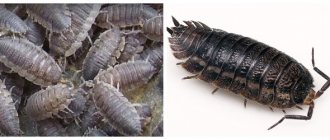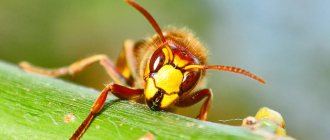Signs of a cutworm
The cutworm butterfly is one of the most common representatives of this family. She does not harm herself, she only lays eggs, from which voracious larvae emerge. They are the ones that harm plants. Depending on the type of pest, there are different methods of control. But there are also a number of general principles.
You can recognize the appearance immediately:
- visually - cutworms are active at night, after dusk;
- during the day in litter and mulch, on the inside of the leaves.
Kinds
Winter
It lives almost all over the world, with the exception of areas with extremely high or low temperatures.
The wings are up to 3.5-5 cm in size. The hind wings are lighter, the front wings can have a yellowish brick or dirty gray color. Older caterpillars overwinter in the soil at a depth of 20-30 cm. As soon as the soil warms up to +10°C in spring, they move closer to the surface and pupate.
The pupae are red-brown in color and have a pair of spines at the posterior end. The development period of the pupa is up to 30 days. The butterfly year lasts 1.5 months - from late spring to mid-summer.
The butterfly is most active in the evening and at night. A couple of days after birth, females lay yellowish or milky white eggs on plants or in the soil. One female can lay 500-1000 eggs up to 1 cm in size.
Caterpillars are born after 5-14 days. In the first and second instars they live on the reverse side of the leaves. Older individuals crawl into the top layer of soil and only come to the surface at night to feed.
The size of an adult caterpillar reaches 5 cm, the body is shiny, grayish-green in color. By the end of July, the caterpillars climb 3-9 cm into the ground and pupate.
Butterflies of the 2nd generation live from mid-summer to early autumn. In the second half of August, they actively lay eggs in areas that previously contained vegetable or cereal crops.
exclamation point
Butterflies with a wingspan of up to 3-4 cm. The front wings are dirty gray, at the base there is a characteristic spot in the shape of an exclamation mark.
The caterpillars are medium in size, body color is dark gray, length is up to 3 cm.
Ogorodnaya
A common species of butterflies that develops in two generations. In individuals of the first generation, years begin in May, in the second - in early August. The eggs are yellowish-green and are laid in a mound on the back of the leaf.
Butterflies have hind wings of a dirty gray color, while the front wings are brownish-brown. The larvae can be of different colors - from green to dark red, body length - up to 3.2 cm.
Cabbage
The wings reach 5 cm, the front wings have an unusual color - gray-burgundy with dark spots and a milky-white line at the leading edge. Across the wing there is a pair of dark stripes with teeth.
The pupa is dark brown. Usually two generations of butterflies are formed per season.
Insects lay 20-50 dark gray eggs on the underside of the leaves. Most often these are flowering weeds, tobacco, sunflowers, cabbage or beets. After 5-14 days, caterpillars emerge from the eggs, eat the pulp of neighboring leaves and spread further.
In adult individuals, the color of the body is brownish-yellow to greenish-black.
The number of generations of armyworms may depend on the region where they live. Thus, in the northern regions, only one generation has time to form - in the spring, butterflies lay eggs, and in the fall the caterpillars hibernate in order to transform into a butterfly next spring. In the southern regions, where the warm period lasts longer, 2-4 generations of insects have time to form.
Prevention measures
Killing caterpillars is not an easy process. To prevent them from appearing:
- alternate different cultures;
- remove weeds, as they provide food;
- collect emerging pests with their hands;
- when the caterpillars increase, a drug is selected for elimination;
Owl butterfly.
- if previous means are ineffective, chemicals are used;
- to combat butterflies, lay eggshells between the rows;
- baits in the form of sweet water are placed in small jars;
- Basil and cilantro are planted so that their aromas repel pests;
- After harvesting, the area is dug deep to reduce the number of surviving insects.
Harm
The most harmful are the gnawing caterpillars - exclamation and winter.
The fall armyworm mainly destroys cabbage and carrots, and winter crops. The first generation caterpillars begin to actively destroy crops in mid-summer. Young shoots of sunflower, rapeseed, millet, and corn suffer the most. The second generation larvae eat planted winter grains.
Plants damaged by the pest die. Basically, the larvae begin their “work” from the edges of the field, then the damage spreads in spots that grow into large bald spots.
Cabbage and garden caterpillars are considered leaf-eating. White cabbage suffers the most from them. The larvae make passages in the head of cabbage and leave behind a trail of liquid waste products. A head of cabbage damaged by the cutworm quickly rots and gives off an infection that can infect other plants.
In broccoli, the pest damages not only the head, but also the leaves. The armyworm also affects other vegetable crops - tomatoes, carrots, beets, cabbage, rapeseed, potatoes, onions, turnips, bell peppers, peas, radishes, and beans. The larvae infect plants in open ground and can make their way into greenhouses. Individuals of the 1st and 2nd instars eat the leaves; adults, in addition to the leaves, also consume the pulp of the fruit. In root vegetables, the caterpillar can eat through an entire cavity, leaving the peel almost untouched.
Expert opinion
Mityuk Stefania Bogdanovna
One caterpillar can destroy up to 15 young plants per day.
How to fight
It is necessary to start fighting insects from the beginning of summer, when the caterpillars are at a younger age - then they cause the least damage to the crop.
To reduce the damage caused by cutworms, you should approach the issue comprehensively.
Destroy weeds
Trichogramma.
All weeds, especially flowering ones, must be removed from the beds and near them. They attract butterflies as a source of food.
Before planting, the area should be cleared of plant debris and the area should be kept clean throughout the season.
Destroy the eggs
This can be done in two ways:
- At the end of spring and mid-summer, during the laying of eggs and the formation of caterpillars, it is necessary to deeply and thoroughly loosen the soil between the rows of plants.
- Use trichograms. These are predatory organisms that destroy cutworm eggs. They must be used during the laying period. In total, you need to carry out 3 procedures with an interval of 6 days, releasing up to 40 thousand trichograms per 1 hectare.
Spray the plants
Crops that can be affected by the pest must be treated with wormwood infusion for preventative purposes.
You need to take 150 g of a green plant, pour 5 liters of boiling water, add 0.5 tbsp. l. liquid soap and half a glass of wood ash. Stir, cover and leave for 4-6 hours. Use immediately after brewing.
You can repel butterflies and larvae by sprinkling tobacco dust on the plants. It is better to do this in the evening or early in the morning, when there is still dew on the leaves. As a powder, you can also use sifted wood ash, dried and powdered herbs of celandine, chicory, wormwood, castor oil or tansy.
From the listed herbs you can also make a solution for spraying - pour the green grass with warm water in a ratio of 1:3 and leave for 48 hours. Strain thoroughly and spray the plants.
Catching butterflies
To do this, you need to place containers with diluted jam or beer on the site. The sweet scent will attract cutworms, but once they get wet, they won't be able to fly away. The liquid in the traps must be changed as they become filled with butterflies.
Molasses troughs or pheromone traps can help track the size of the cutworm population on a site. This product is effective for all varieties of cutworms and allows you to catch females before oviposition. The data obtained will make it possible to determine the timing of egg laying, the density of insects and the number of Trichogramma necessary for pest control.
Destroy the caterpillars
Larvae of the 1st-2nd instar can be destroyed with biological products:
Biological activity – 1500 EA/mg. For 10 liters of water you need to use 50 g of the product (2 kg/ha).
BA - 2000 EA/mg, per 10 liters of water you need to use 50 g of the substance (1.5-2 kg/ha).
You need to spray the plants with a freshly prepared solution. The optimal air temperature is 18°C and above, without dew or precipitation. It is best to spray plants in the evening.
If after spraying some caterpillars remain on the plants, re-treatment can be carried out no earlier than a week later.
Insecticides can also be used. It is important to follow the manufacturer’s recommendations and not spray crops that are resistant to pest attack.
The dosage is different for each type of crop being treated.
For 20 liters of water you need to use 4 ml of the drug.
For 20 liters of water – 3 ml of the drug.
The following drugs are used to protect cabbage from pests:
Stops the insect's life cycle and prevents the laying of new eggs.
Low toxic pesticide.
Low toxic growth regulator.
Pesticides can be used on eggplant, pepper and tomato plantings only before fruit formation.
Get rid of the pupae
After harvesting, you need to carefully dig up the soil on the site. It is advisable to do this in late autumn with the onset of cold weather - the pupated caterpillars will die from the low temperature. The same should be done in early spring so that the pupae are at greater depths and cannot escape into the air.
Do you use chemicals to combat armyworms?
Of course! I don’t use it
Also, as a preventative measure, in early spring you can plant plants along the edges of the bed whose smell repels insects - marigolds, dill, parsley, nasturtium, lemon balm, calendula or chrysanthemums.
You need to understand that once you get rid of the scoop, you shouldn’t relax. New insects can travel long distances in search of a comfortable place to lay eggs. Prevention and timely response to the appearance of a pest is the key to a good harvest.
Ways to repel mole crickets
Mole crickets love warmth and dampness, so they try to get into manure or compost heaps. Such heaps should be fenced off with sheets of metal or slate, dug to a depth of at least 50 cm.
Mole crickets can be scared off in the following ways:
- plant the beds around the perimeter with marigolds, chrysanthemums or calendula;
- Place pine, spruce or larch needles on the paths;
- Every one and a half to two meters, stick an aspen or alder peg made of fresh wood into the ground. Change pegs as they dry;
- as a preventive measure, before planting tubers, throw a little onion peel or a crushed clove of garlic into each hole; before planting, water the beds with a weak solution of iodine (20 drops per bucket of water);
- Be sure to add an infusion of onion peels to the liquid for watering potatoes;
- chop small fish or the insides of regular fish. The resulting mass can be used fresh or left in a closed container for several days to allow it to spoil (not all people can tolerate this smell). Before planting the tubers, put a little fish mush in each hole and sprinkle with soil.
Mechanical methods of control
Some gardeners collect cutworm larvae and large ovipositors on tomatoes by hand. But this can be done if the bed is small, but on a farmer’s field it is very problematic.
It is much easier to set up traps for cutworm butterflies in beds with tomatoes, both in a greenhouse and in open ground:
- place containers filled with beer, fermented jam or molasses diluted 3 times with water;
- Like all nocturnal moths, cutworms willingly fly into the light; they can easily be sprayed with insect repellent from a spray can or, if desired, killed by hand.
Nematodes
The worst pest of potatoes (see photo) is the microscopic golden nematode. The worms, about 1 mm long, live in the soil for about 8-10 years. They overwinter as eggs and larvae in cysts, and when warmer, they penetrate into the root system of plants. Feeding on plant tissues and juices, they grow to adult individuals, which, after fertilization, lay eggs inside themselves and then die. There are several types of nematodes:
- gall - damages the roots of the crop, potatoes in the ground;
- stem - affects the ground part of plants, appears on tubers during storage;
- soil - parasitizes the roots of potatoes.
When affected by a nematode, the bushes stop growing and turn yellow. During the flowering phase, the buds are small or absent, tubers are not formed. The pest appears when agricultural practices are violated, there is no crop rotation on the site, or when planting infected seed material
Maliciousness
Potato cutworm larvae are harmful. These voracious creatures do quite a lot of damage to vegetable and berry crops. Crawling deep into the stem and fruit, they eat holes in them. In addition, this parasite is capable of nibbling the ovaries of berry crops, flowers and even rhizomes. As a result, the infected bush begins to wither, dry out and lose foliage.
The potato cutworm is especially dangerous in waterlogged areas. As you know, humidity promotes the development of pathogenic microorganisms that easily penetrate the body of the affected plant. The pest gnaws the stem at the soil level, enters the tuber through it and continues active feeding. Thus, the skin of the fruit remains intact, while its pulp is almost destroyed.
On a note! If an area is heavily infested with potato cutworms, you can lose up to 50% of the fruit!
This type of cutworm feeds not only on potatoes. This pest often affects:
Description of the pest and its diet
Three main colors of the bat are observed:
The armyworm is recognized as the most dangerous pest in the post-Soviet countries. Its “menu” includes about 40 cultivated crops.
On the wings of some species there is an original pattern resembling the letter of the Greek alphabet - gamma.
The remaining representatives of the genus surprise with chaotic “prints” in the form of longitudinal stripes of a contrasting shade. The lifespan of a moth is one month. During this time, females manage to lay up to several hundred eggs on the back of the leaves. After 10-12 days, the larvae hatch from them. It is these caterpillars that pose a threat to vegetable crops. After birth, they immediately begin to feed on juice :
In the southern regions, the butterfly flight season opens in May, and in the northern regions - in mid-June.
Lepidoptera begin to mate within the first 2-3 days, after emerging from the pupae. The females then lay eggs. One such clutch can contain up to 20-150 eggs. The total fertility of individuals per season is 600-2700 eggs. The period of appearance of larvae varies from 4 to 12 days. The development of caterpillars is observed within 24-50 days.
Learn to distinguish cutworm species
Perhaps this issue deserves special attention.
Each species of moth attacks different varieties of crops. Despite the fact that there are thousands of species around the world, farmers will be especially interested in the cutting armyworm. Methods of combating representatives of the Lepidoptera family are quite varied. But before you deal with them, you need to identify one of the subspecies of insect pests :
The garden cutworm is a leaf-eating pest that lives on the soil surface. Moths are distinguished by their brownish-brown color and mosaic pattern. The larvae are most often light green or coffee-bronze.
Insects usually feed on:
The vital activity of butterflies occurs in the evening and at night. Lepidoptera overwinter in the soil at a depth of 10-25 cm.
Another representative of the leaf-eating genus is the cabbage cutworm. The span of its gray-brown wings reaches 45-50 mm. Along the edges, the mosaic pattern takes on clearer outlines and resembles ruffles. The caterpillar goes through up to 5 stages of molting and 6 instar transformations. It is distinguished by its light green or rich brown hue.
